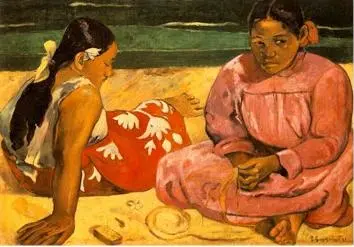
Post Impressionist Paul Gauguin is highly recognised for his focus on colour, two dimensional forms, and the symbolic meaning of his art.
Primarily known for his paintings, he was also a printmaker and creator of ceramic sculptures and woodcarvings.
He was a financially successful stockbroker and self-taught amateur artist, influenced by the avant-garde art of the 19th Century through his legal guardian’s collection of works by Camille Corot, Gustave Courbet, Eugene Delacroix, Honore Daumier, Theodore Rousseau and early works by Camille Pissarro, amongst many others.
His earliest recorded major painting to survive is Working the Land, painted in 1873. The brilliant blue of its sky and the brightness and of the greens and yellows in the field were reminiscent of landscapes of the four seasons that Pissarro had recently completed.

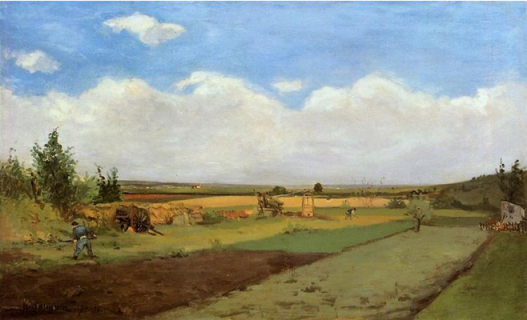
It is probable that his intimate knowledge of Pissarro’s landscapes was a key factor in his interest in the Impressionists, and the 1870s he began collecting their artworks, and then adopting some of their techniques (under Pissarro’s tutelage). He was also influenced by Paul Cezanne’s parallel, constructive brushstrokes.
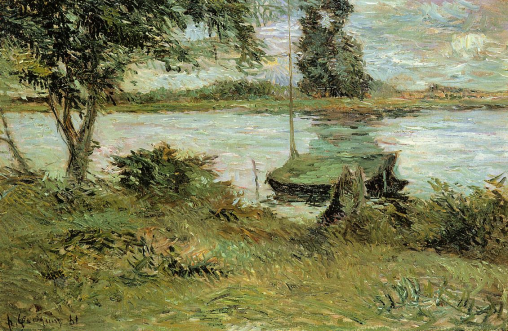
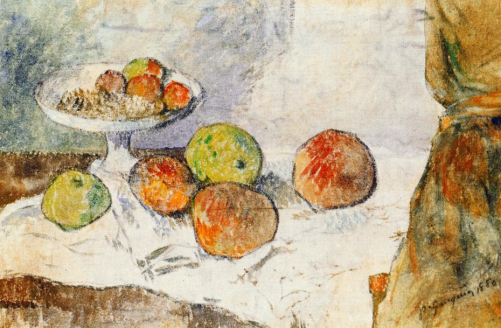
Encouraged by both Pissarro and Edgar Degas, Gauguin contributed to five of the eight Impressionist exhibitions between 1880 – 1882. He also contributed to the debates and discussions that took place between the artists gathering in Montmartre, questioning the nature and role of art in modern society.
In 1882, after a stock market crash and recession left him unemployed and financially ruined, Gauguin abandoned the business world to pursue life as a full-time artist.
When working in Brittany and Martinique, the year after the final Impressionist exhibition, he began the artistic transformation to Post Impressionism with which we are more familiar today, and the creator of “primitive” and exotic images overlayed with symbolic meaning.
In 1886, he first visited Pont-Aven in Brittany, a rugged land of fervently religious people. Gauguin had received a seminary education in his youth and his religious beliefs never deserted him – although he increasingly questioned the strictures of the traditional Catholic church. In Pont-Aven he hoped to tap into the expressive potential he believed he would find in a more rural, even “primitive” culture.
Over the next several years he often travelled between Paris and Brittany, and also spent time in Panama and Martinique.
In 1888, he worked with Émile Bernard, Louis Anquetin, Paul Sérusier and others in Pont-Aven, developing new theories of painting. They adopted a style of painting known as Synthetism. Synthetism referred to the synthesis of simplified forms and colour schemes with the main idea or feeling of the subject, in order to produce a bolder artistic statement. Essentially the Pont-Aven artists reduced three-dimensional figures and shapes to flatter two dimensional forms with heavy dark outlines (also known as Cloisonnism).
For Gauguin, painting also had a symbolic focus, with a brighter palette designed to express human emotion. The new style was, in part, inspired by Gothic art (particularly stained-glass and enamel work) and Japanese ukiyo-e woodblock prints (Japonisme), which were in vogue amongst many artists of the Pont-Aven school. A key painting from this period was Vision After the Sermon which became an important Symbolist work statement.
Gauguin also worked alongside Vincent van Gogh (whom he probably met in Paris during the previous year) in Arles in the south of France in the summer of 1888, at the time that van Gogh was attempting to set up an artists’ colony.
Both artists continued to experiment with compositional techniques derived from Japanese art, as well as the symbolic ‘language’ of colour, seeking to emphasise subjective feelings and ideas over naturalistic representation. However, Gauguin and van Gogh argued badly (it was at this time that Van Gogh reportedly cut off part of his left ear) and Gauguin returned to Paris.
In 1891 he moved to Tahiti, where he expected to find an unspoiled culture which was exotic and sensual. Instead, he was confronted with a world already transformed by western missionaries and colonial rule. He had to re-imagine or ‘ invent’ the world he sought, not only in paintings but with woodcarvings, graphics, and written works which generally present an image of an intoxicating earthly paradise where the painter lived as a native among the natives.
However, he also struggled with ways to express the questions of life and death, knowledge and evil that preoccupied him, and he interwove the images and mythology of island life with those of the west and other cultures.
He painted such works as Where Do We Come From? What Are We? Where Are We Going To? in 1898. This work was an enormous contemplation of life and death told through a series of figures, beginning with a baby and ending with an old woman, and is surrounded by a dreamlike, poetic aura.
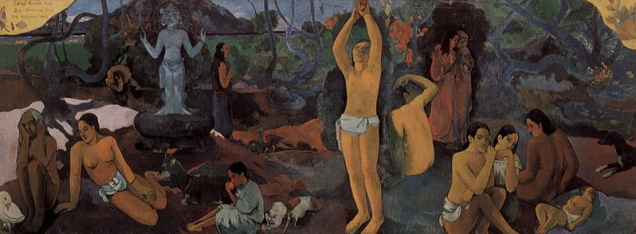
After a trip to France from 1893 to 1895, Gauguin returned to the South Seas. However, by this time he was suffering from illness and depression. In 1901 he moved to the Marquesan island of Hiva Oa, still searching for a lost paradise. “I think the savage element there, together with complete solitude, will revive the fire of my enthusiasm before I die, give new life to my imagination and bring my talents to a fitting conclusion.” He died there in 1903.
In this blog I have focused on Gauguin’s artistic achievements, but commentaries on his personal life are not so complimentary. A key question you may wish to consider is whether your knowledge of an artist’s personal life influences how you feel about their art.
This blog is just a short excerpt from my art history e-course, Introduction to Modern European Art which is designed for adult learners and students of art history.
This interactive program covers the period from Romanticism right through to Abstract Art, with sections on the Bauhaus and School of Paris, key Paris exhibitions, both favourite and less well known artists and their work, and information about colour theory and key art terms. Lots of interesting stories, videos and opportunities to undertake exercises throughout the program.
If you’d like to see some of the Australian artwork you’ll find in my gallery, scroll down to the bottom of the page. You’ll also find many French works on paper and beautiful fashion plates from the early 1900s by visiting the gallery.














Very informative
Thanks for your comment, I take time with my blogs/on-line program to provide information and images that are not be so easy to find with a general web/hardcopy search, and that I hope others will enjoy.